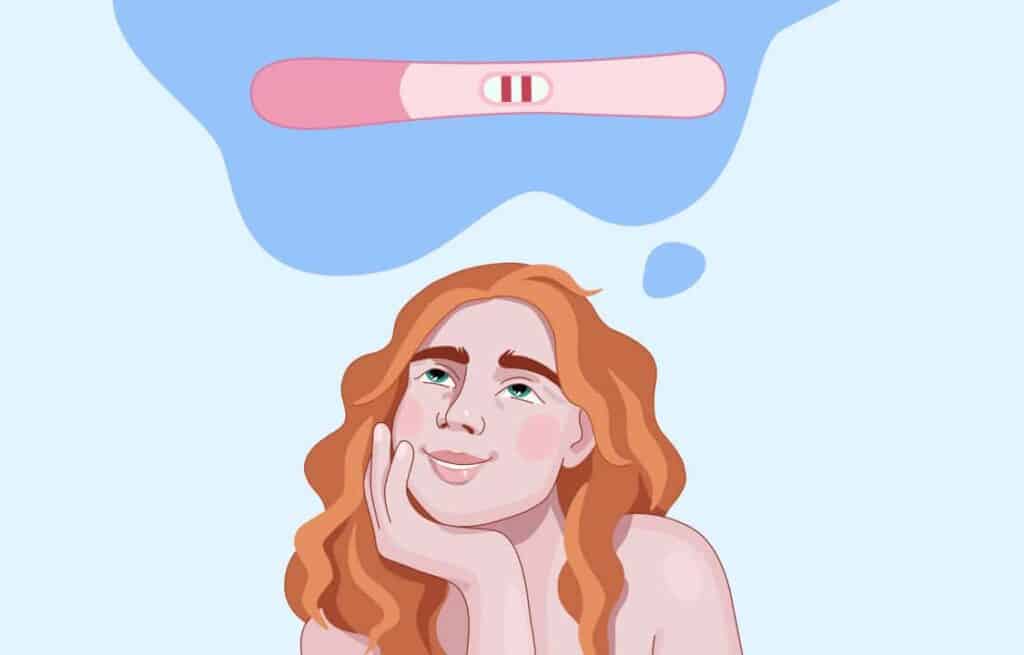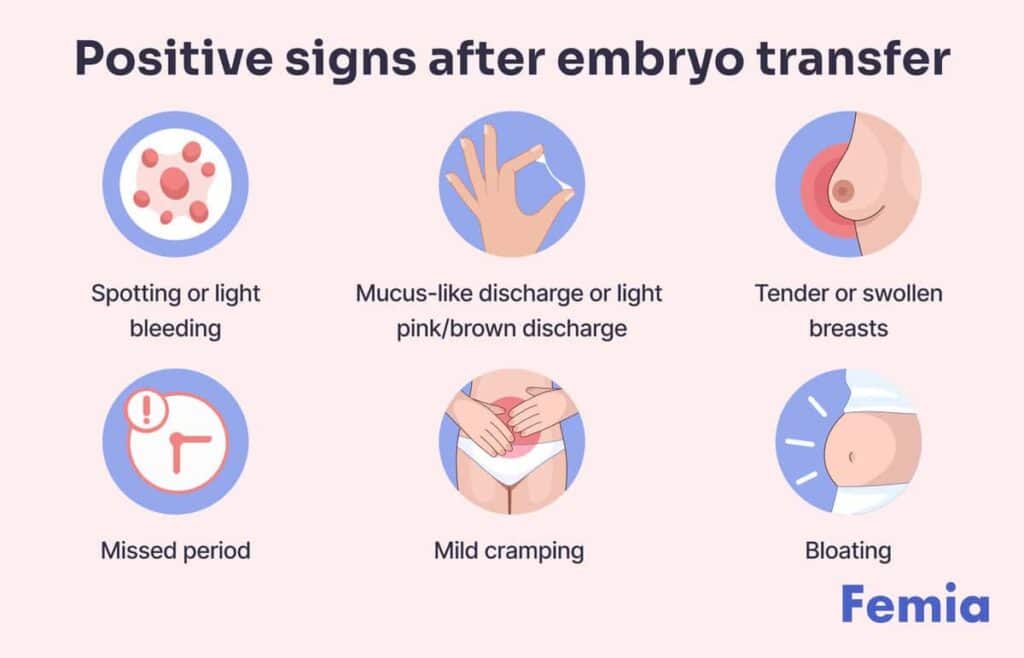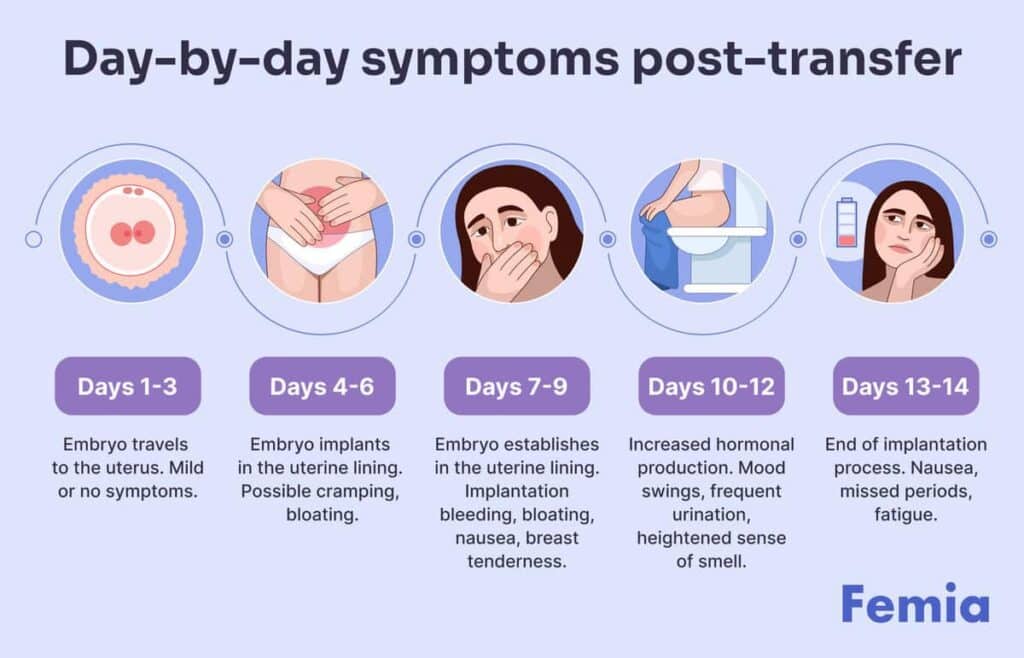Femia > Health Library > Getting Pregnant > Positive signs after embryo transfer
Positive signs after embryo transfer

- Updated Mar 2, 2025
- Published
CRAFTED BY HUMAN
Crafted by human At Femia, we provide accurate and up-to-date information at every stage of your journey, from trying to conceive, pregnancy and postnatal support. All content is created by a real person based on in-depth research and own professional experience. Femia ensures that you will receive expert advice, strict accuracy and a personalized approach from our authors/medical experts. Learn more about our editorial policy.
FACT CHECKED
Fact checked At Femia Health, we maintain the highest standards of editorial excellence in delivering content focused on helping you conceive, guiding you through pregnancy, and supporting you postpartum. Explore our content review principles to learn how we ensure the accuracy and quality of our health and lifestyle tips for every stage of your journey.
The most common positive signs after embryo transfer that may indicate a successful pregnancy include missed periods, cramping, spotting or mild implantation bleeding three to seven days after implantation, vaginal discharge, breast tenderness, and tiredness.
However, these signs also occur due to the side effects of medication taken during and after the embryo transfer. So, a serum beta HCG or urine pregnancy test done two weeks after embryo transfer remains the most accurate indication of a successful pregnancy.
The time between your embryo transfer and the moment you can take a pregnancy test can be one of the seemingly endless periods of your life.
Hence, it is natural to keep looking for both negative and positive signs after embryo transfer to predict if your pregnancy has been successful or not.
Embryo transfer is one of the most significant steps in the in-vitro fertilization process. This is when a fertilized egg are directly inserted into a woman’s uterus through a long, thin catheter. It is a common procedure for someone who needs assisted reproductive technology to become pregnant, typically unable to get pregnant naturally after more than one year of unprotected sexual intercourse.

Positive signs after embryo transfer
Although a pregnancy test, like serum beta HCG, is the most accurate indication of successful implantation, there are also some positive signs you can look for after your embryo transfer that may indicate a successful pregnancy.
The expected positive signs after embryo transfer include:
- Light bleeding or mild spotting. One of the indications that your embryo transfer is successful is light bleeding or mild spotting. You may experience it 3 to 5 days after your implantation.
- Stomach cramps or discomfort. You may also experience cramps in your lower abdomen after the embryo transfer. It commonly occurs as your uterus contracts and adjusts with the embryo. It may be a positive sign of successful implantation, especially if your menstruation date isn’t near.
- Vaginal discharge. Excessive vaginal discharge is also a sign of early pregnancy. If your embryo transfer procedure has been successful, you may have any of the following types of discharge:
- Excessive mucus-like discharge;
- White discharge that has a mild smell;
- Thin, clear, or watery discharge;
- Mild pink or brown discharge may be a sign of spotting that happens because of implantation bleeding, indicating a successful pregnancy.
- Missed periods: If you miss your periods after the embryo transfer, it may also indicate that you may be pregnant.
- Breast soreness: If you experience swollen breasts or breast tenderness when you touch them, it may be a sign that the embryo transfer procedure was successful.
👉Find out more: Signs of pregnancy after Depo-Provera

@femia.fertility We know, dear, it's frustrating when you were hoping to take a pregnancy test soon, but your period has started #implantation #ttc #Cutmeme #periodtok #ttcproblems #pregnancytest ♬ original sound - Femia fertility tracker
No symptoms after embryo transfer: is that normal?
It is essential to know and remember that your body is different from every other person. This means that how your body reacts to the embryo transfer procedure may also be different from any other implantation case.
Hence, you might not necessarily experience all or any of the positive embryo transfer symptoms to indicate a successful pregnancy.
Just like not every person may face side effects from a certain medication, not every individual may experience embryo transfer symptoms. So, it is entirely possible to have zero symptoms of a positive embryo transfer but still be pregnant.
The actual confirmation of pregnancy is made from a serum beta HCG test.

Bodily changes after embryo transfer
When you schedule an embryo transfer procedure, your doctor will prescribe you certain hormonal medications for supporting the implantation and early pregnancy.
As a result of the combined effects of the medication and embryo transfer, your body will undergo significant hormonal changes and fluctuations.
The hormonal fluctuations resulting from post-transfer and medications can lead to various physical symptoms, like:
- Bloating;
- Mild cramping;
- Spotting;
- Lower back pain;
- Dizziness;
- Tiredness;
- Sore breasts.
These physical signs of hormonal changes from post-transfer are similar to the positive signs after embryo transfer that may indicate a successful pregnancy. So, you may experience them even if you aren’t pregnant.
👉Find out more: Ultimate pre-pregnancy checklist: Essential steps to take before having a baby
Day-by-day symptoms after embryo transfer
It takes around 12 to 14 days for the embryo transfer to turn into a successful pregnancy. During the entire process, you may experience symptoms with different intensities depending on your body’s response.
Here are the symptoms you may encounter after your embryo transfer, from day 1 to day 14:
1. Day 1 to day 3
This phase is the beginning of your implantation. From day 1 to day 3, the embryo is inserted in your body. This is done using a thin tube called a catheter that is placed into the womb through the vagina. The embryo then moves towards the uterus, and prepares for implantation. Your fertility doctor will guide this transfer by an ultrasound.
As day 1 to day 3 is considered the initial process of development or embryo settlement, you may experience mild symptoms or even no symptoms.
On day 2 or 3, the symptoms like mild cramping or spotting begin to develop.
2. Day 4 to day 6
Day 4 to day 6 is the phase when the embryo has developed and settled in your uterus. Now, the next step begins, and the embryo gets implanted in the lining of the uterus.
This phase increases symptoms of cramping, constipation, breast soreness, and urination as the embryo is adjusting in your uterine lining and causing changes in the body.
3. Day 7 to day 9
Day 7 to day 9 is the phase when the embryo settles and develops further in the uterine lining, which results in increased intensity of body and hormonal changes.
The symptoms of implantation bleeding, swollen nipples, nausea, and bloating commonly occur in this phase.
4. Day 10 to day 12
Day 10 to 12 is when the embryo development and production of hormones in the body progresses and becomes faster.
Hence, you may experience a combination of mental, physical, and hormonal changes.
The symptoms of day 10 to day 12 include abdominal cramping, tiredness, mood fluctuations, and increased hunger and thirst.
5. Day 13 to day 14
Day 13 and day 14 are the last phases of embryo implantation. In this phase, you can get your serum beta HCG or urine test for pregnancy to confirm if your implantation was successful.
The symptoms of early pregnancy, like no periods, nausea and vomiting, back pain, and cramps, commonly appear in this phase if your embryo transfer is successful.
👉Find out more: Enhancing fertility naturally: A guide to fertility supplements and foods for women

Common symptoms and their meanings
You may also experience the following symptoms after your embryo transfer:
No white discharge after embryo transfer
White discharge after embryo transfer normally occurs as a result of hormonal body changes and the side effects of the estrogen and progesterone medications given during treatment.
If you are experiencing no white discharge after embryo transfer, this is because every body reacts differently to hormonal changes and the implantation process.
Just like some women experience pain while they are on their periods, some women experience no pain at all. Both conditions are normal.
Hence, no white discharge after embryo transfer is normal and does not indicate that you are not pregnant or the implantation was unsuccessful. Only a pregnancy test can confirm whether you are pregnant or not.
No spotting after embryo transfer
Spotting after embryo transfer occurs due to rupturing of the capillaries in the uterine wall when the embryo implants, leading to mild spotting or bleeding.
No spotting after embryo transfer may occur due to the difference in the structure of your uterine lining, the difference in your hormonal levels, or how the embryo implantation takes place.
This means spotting can vary from person to person, and no spotting after embryo transfer may be due to natural body processes.
So, it’s totally normal not to experience spotting after embryo transfer, even if the implantation is successful.

No breast tenderness after embryo transfer
Breast tenderness after embryo transfer also occurs as a result of hormonal changes in the body and medications taken during the treatment.
If you experience no breast tenderness after embryo transfer, it doesn’t always mean that you are not pregnant.
Simply, it may be due to variations in how your body is reacting to the embryo transfer and implantation, or you may generally be experiencing fewer side effects of hormonal medications.
Cramping after FET
Mild cramping after FET (frozen embryo transfer) is normal and occurs because of the embryo implantation into your uterine lining and hormonal changes in your body.
Nausea after FET
Nausea after FET may be an early sign of pregnancy, but not experiencing nausea is also normal. In either case, having nausea may not necessarily indicate a positive pregnancy, as it can also be a side effect of the hormonal medications taken during embryo transfer.
Mucus discharge after embryo transfer:
The type of vaginal discharge you may experience or any changes in the discharge after embryo transfer can be different compared to other individuals.
The color, consistency, and volume of discharge vary from person to person, depending on how the individual body reacts to the implantation process.
Signs of a successful embryo transfer
If your embryo transfer has been successful, you may experience the following signs of early pregnancy more prominently approximately 7 to 9 days after implantation:
- Nausea and vomiting;
- Morning sickness;
- Implantation bleeding;
- Fatigue;
- Mood swings;
- Breast tenderness;
- Positive pregnancy blood or urine test.
However, it is important to remember that the absence of these signs does not mean pregnancy has not occurred.
The only sure confirmation is if you get negative results from a pregnancy test 9 to 14 days after implantation.
Questions from the Femia community
How soon can I take a pregnancy test after embryo transfer?
If you want the most accurate results, healthcare providers recommend waiting for 12 to 14 days after the embryo transfer before getting your pregnancy test.
However, the earliest time you can take one is 7 to 10 days but run the risk of getting false results.
Are the symptoms different for a fresh vs a frozen embryo transfer?
As both fresh and frozen embryo transfers involve a similar technique and lead to hormonal fluctuations in the body, the symptoms of both types are typically the same.
However, symptoms can vary in each individual, as every person's physiology and how they react to the implantation may be different.
What should I avoid doing after an embryo transfer?
After the embryo transfer procedure, you may experience enlarged ovaries. Hence, it is recommended to avoid sexual intercourse and vigorous activities, like weight lifting and running, after your implantation to avoid discomfort.
You may ask your healthcare provider how long to refrain from these activities, as well as any specific guidelines for post-transfer care that you should follow based on your condition.
Should I continue taking my medications after the embryo transfer?
Yes, you will have to take some medications after the embryo transfer procedure, as recommended by your healthcare provider.
These medications help support and stimulate the implantation and improve the chances of the embryo turning into a successful pregnancy.
For example, you will be prescribed progesterone throughout the in-vitro fertilization process to facilitate the implantation, thicken the uterine lining, and support early pregnancy. If you get a negative pregnancy test, only then you will stop taking progesterone. Even then, some doctors recommend to continue progesterone until 8-10 weeks of pregnancy.
What signs should prompt me to contact my doctor after an embryo transfer?
Symptoms like spotting or mild bleeding, vaginal discharge, cramps, and bloating after an embryo transfer are normal. However, if these symptoms get severe, abnormal, intolerable, or very unusual, it is recommended to contact your healthcare provider immediately.
Can I travel after an embryo transfer?
Traveling has not shown any adverse effects after an embryo transfer and is generally considered safe. However, as you may face some hormonal bodily changes after implantation, like cramps, bloating, spotting, or fatigue, you may want to rest and avoid long travel immediately after the procedure.
The bottom line
Embryo transfer is a procedure that results in hormonal changes in your body. So, symptoms like cramping, tiredness, spotting or light bleeding, mood fluctuations, vaginal discharge, or any other mild side effects due to medications or procedural effects are natural and a part of the process.
It happens because your body is adjusting to the hormonal changes, or the implantation process may be taking place.
However, for any unusual or intolerable side effects, like heavy bleeding or severe pain, we recommend contacting your doctor for advice based on your health condition.
Symptoms after embryo transfer differ from individual to individual. Some patients experience no or minor symptoms or side effects, and some face all symptoms. Hence, only a positive pregnancy blood or urine test taken 14 days after the implantation can confirm your pregnancy.
References
- In Vitro Fertilization (IVF) – Mayo Clinic. 1 Sept. 2023, www.mayoclinic.org/tests-procedures/in-vitro-fertilization/about/pac-20384716
- Professional, Cleveland Clinic Medical. “IVF (in Vitro Fertilization).” Cleveland Clinic, https://my.clevelandclinic.org/health/treatments/22457-ivf

Explore the differences between C-sections and vaginal births including risks recovery time and what factors you should consider before making a choice.

Discover what happens at 13 weeks pregnant, from baby’s development and bump changes to ultrasound insights and common symptoms.

Look out for these danger signs of pregnancy during your second trimester which require immediate medical attention.

